Southwest Rib
July 12, 2002
Emily and I pulled into the Blue lake trail head late Thursday night to avoid the early morning wakeup that trips to Washington Pass require. For some reason I took my shoes off before going outside to micturate. Two steps out of the car and I plant my bare foot right in someone's melting-out turd. Apparently when they crapped in the snow, it didn't just magically disappear!
We were up and out the car-door at 9 a.m. the next morning. The basin there is mostly melted out, so there was no hope of taking a direct route up to the spires. Thus we walked along the trail of nonsense that parallels the highway for a good half mile.
Higher up in the basin, just under the gully leading to Liberty Bell, we hopped on the snow and made quick time through the boulder fields up to the base of the Southwest Rib.
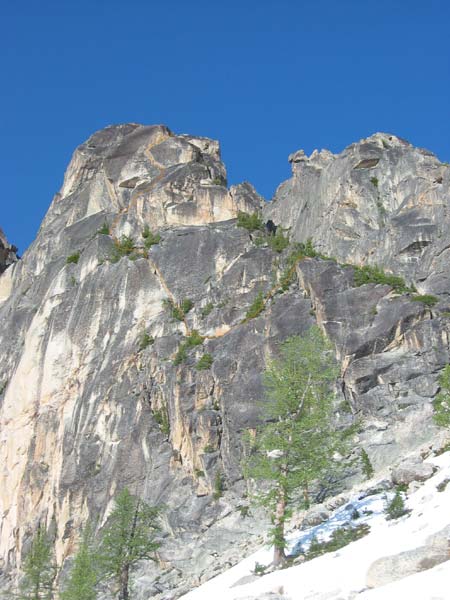
The Southwest Rib of South Early Winter Spire.
We were planning on doing a direct "variation" start, but the crack systems looked pretty vegetated. We decided to contour around to the SW Couloir and take the normal route over the chockstone.
After racking up, we running belayed up to the crest of the rib, and then downclimbed several steep steps to the base of the route proper. The crack above forms the only weakness in a steep blank wall, and is the crux of the route.
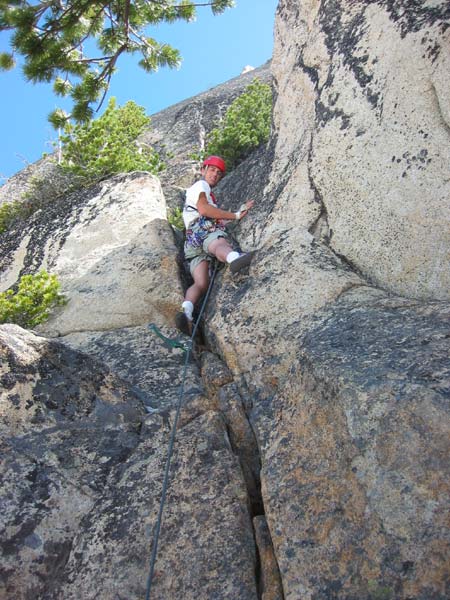
Dave leads off on the start of the first true pitch. Photo by Emily.
Fun climbing leads off the ledge, and then up to a tree that is intimately entwined with the base of the 5.8 crack. I slung the tree and headed up the crack on sweet straight in hand jams. The leaning position of the crack is a bit awkward, and I was glad to have switched the rack onto my left side.
I placed my no. 4 friend (#3 Camalot size), and slid it along with me until I reached a small bulge in the crack. Sticking my hand into a hole in the ground above, I pulled through onto a "ledge" in the crack. The crack was so wide here that not even the #4 Camalot would fit. Thus I had to grunt it up the edge of the chimney/crack, cowboy style. I immediately felt sorry for Emily who was carrying the pack. One last chimney section and I was on a comfy and shaded belay ledge.
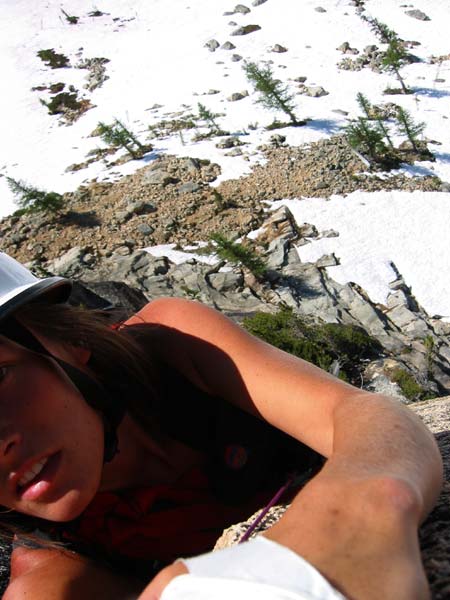
Emily catches the nice exposure on the crux pitch.
Emily lead the next pitch which ended up being a corner crack up to another big ledge.
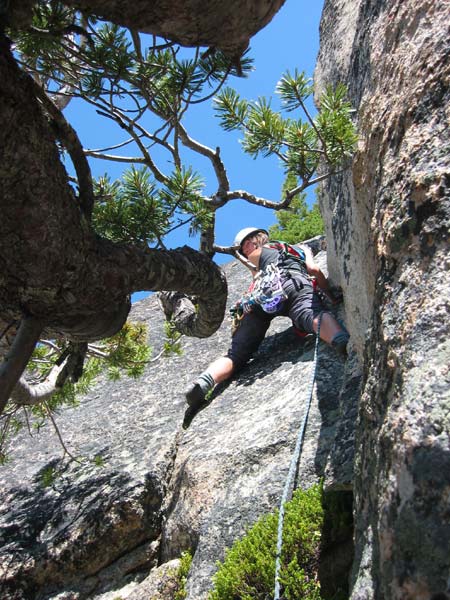
Emily on the second pitch.
The guidebook describes the next pitch as 5.6+ on a runout, licheny slab. Hmm, I lead off around a corner and then up the slab. There was actually pretty good pro with medium-small cams, and I began to get smug about it being "runout." I reached a little flake, and then headed up higher on fun face climbing. About 15 feet above and right of my last piece came the reachy step-across on little sloping holds. Whew! I can see that as being called runout and awkward.
Emily soon joined me at the nice belay ledge, and commented on how enjoyable the last pitch was. Up next on the agenda was the "bear hug" pitch. Instead of something like "climb obvious cracks" in the guide, Beckey actually describes the exact sequence needed to climb the twin 6" cracks. Not only that, he tells you what piece to bring. Whoa!
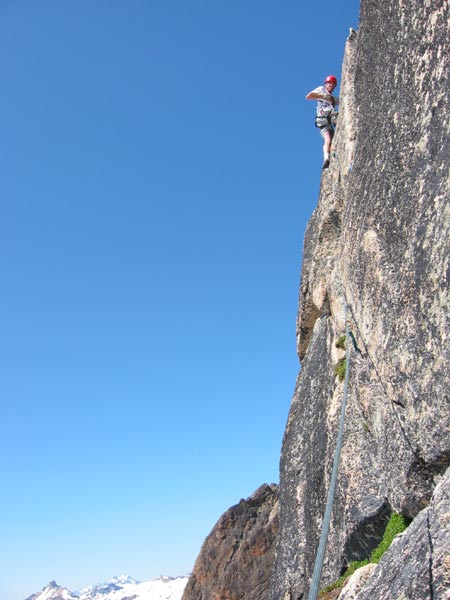
Dave leading the "Bear Hug" pitch. Photo by Emily.
A short lie-back leads to the base of the cracks where a #4 Camalot just fits in the base of either crack. I pulled through the first steep move and tried the slide the cam up a bit. Unfortunately, it had passed that critical width threshold, and started flopping around fully extended in the crack. I set it back down and climbed up to the top of the massive flake. From here, easy 4th class leads to a big mantle and then up through blocks to a ledge at the top of the "Dolphin" feature. From here, Emily took the lead and headed up a flaring crack towards the crest of the rib.
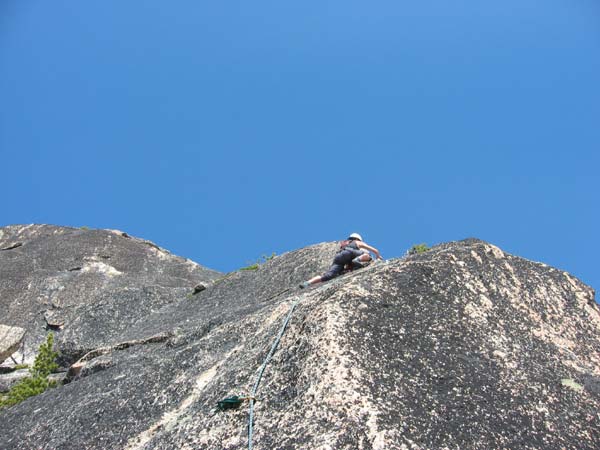
Emily reaches the crest on pitch 5.
Around the corner from an airy traverse, she set a belay due to bad rope drag. Above, the climbing looked pretty moderate, so we set off towards the Rabbit Ear towers (really justt two big flakes) with Emily leading a running belay. We swapped gear and I traversed down into the gully below the summit tower. At the head of the gully, a short 5" crack leads to the summit.
About the time I reached the summit rocks, Emily had just reached the crack. I sat down in a belay seat and brought her up. We had climbed the route (~7 pitches) in 4.5 hours.
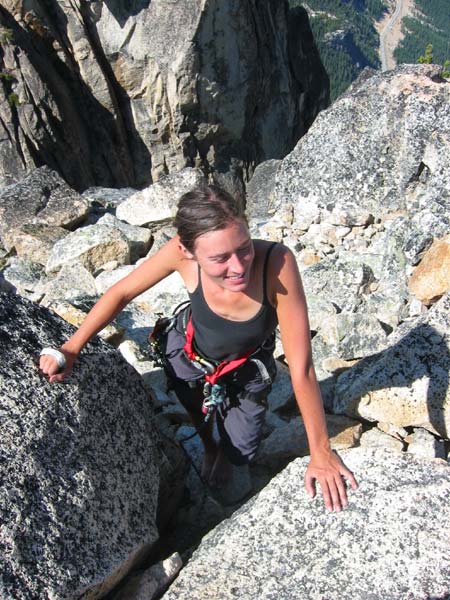
Emily on the Summit.
It was another beautifully clear day, and we enjoyed the views of the North Cascades.
After a quick break, we decided to descend the SW Couloir. It had looked invitingly easy to descend on a previous trip, and enticed us with the possibility of not rappelling.
Climbing down in a running belay, 25 meters apart, worked perfectly. There was a solid rap station to clip every ropelength, and it was decently easy going, less the loose piles of rock everywhere.
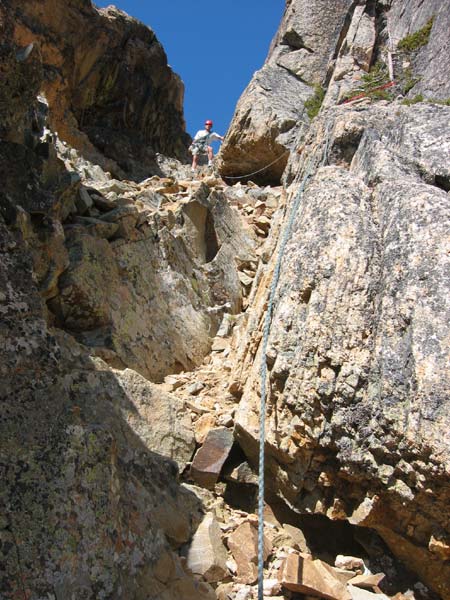
Descending the Southwest Couloir. Photo by Emily.
Just before the couloir becomes a trail, there is a steep wall. We decided to make a single rap off of some equalized trees instead of downclimbing the poorly protected terrain. Soon we were down to the chockstone, and another short rap brought us back to the packs.
The Southwest Rib had been everything I was hoping it would be: a slightly longer route (than the S. Arete) with excellent crack and face climbing at a higher grade. Yet another gem on solid granite in the Liberty Bell group!